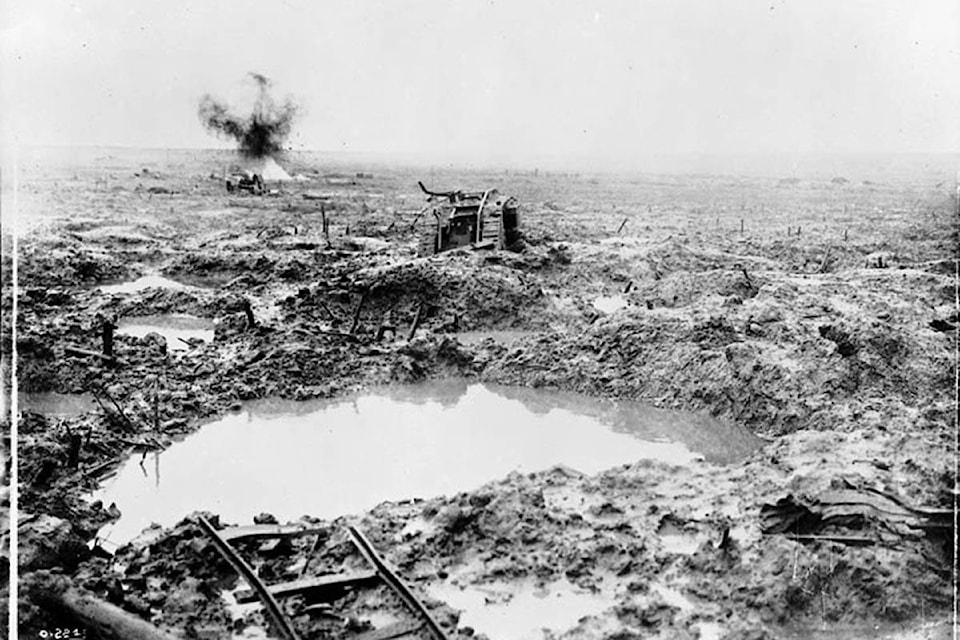Doug Carey
Observer Contributor
….. and the guns fell silent. On the Eleventh Hour of the Eleventh Day of the Eleventh Month the “Great War,” the “War to End all Wars,” was over.
For the victors it was a time of great joy, but for the vanquished foe, there was great despair, turmoil and an uncertain future.
Canadians fought on what was known as the Western Front during the Great War, from 1914 to 1918. This was the bloodiest war fought up to that time. Shortly after hostilities broke out, the fighting in Belgium and France soon became a stalemate and both sides dug in. Very little ground was gained or lost. This was the onset of what became “trench warfare.” Trench lines on both sides stretched from neutral Switzerland all the way to the North Sea coast. These lines were supported by countless supply trenches, forward aid stations and rest areas. The rear areas were used for marshaling supplies, reinforcements and artillery emplacements.
The area between the combatants, known as No Man’s Land, was a maze of barbed wire interspersed with listening posts, where one side hoped to hear what the other was up to as well as spotting for artillery barrages. Night raids out into No Man’s Land had little strategic importance, but they were tactical in that they gave an insight of the other side’s defences. Trench raids were commonplace.
It was soon learned that trenches could not be constructed in a straight line, as this would leave them open to enemy aircraft strafing attacks. That is why all of these trenches appear to zig-zag haphazardly across the landscape.
It was during this time of stalemate that military leaders on both sides toiled to develop new tactics to deal with this style. Initially, it was thought that a head-on charge would dislodge the enemy, but with the use of machine-guns, the other side was able to repel such attacks with very heavy losses for those mounted cavalry units or infantry soldiers “going over the top.” This had become a mechanized war, and both sides suffered horribly.
In an effort to quiet the machine guns, subsequent attacks were preceded by horrendous artillery barrages in order to soften up the defences. These barrages had advantages as well as disadvantages. The enemy kept deep in their trenches or in fortified bunkers, but the ground between was soon obliterated and, with the rains, turned into a muddy morass. Men fell into shell holes and were often never seen again. Variations of this opening barrage were used and what proved more effective was called a “rolling barrage.” As the men moved forward, so did the shelling just ahead of them. This, as you can well imagine, required precise timing, which was often hampered by cut communication lines and confusion.
Battalions of soldiers were tasked with tunnelling deep under the enemy’s trench system, where they would place explosives to disrupt the enemy. This occurred on both sides, and there were times where one group of tunnellers would be undermined by an enemy group working beneath them. Listening posts gained new importance.
As the losses multiplied, with no significant gains, morale dropped and the warring governments needed to answer to the populace at home. This brought out the worst in man. Poison gas attacks were used by both sides with terrible effects on soldiers. Mustard gas was an indiscriminate killer and at times the clouds of gas would drift back onto the attackers with a simple shift in the wind.
Another development of this new mechanized war would be the tank. One might wonder how they got that name. These rather clumsy armoured vehicles were being developed in secret and, during testing, when asked by a curious observer what it was, the reply was a “mobile cistern.” Fresh water was at a premium out in the trenches. They soon got the name “tank” and they have known as that ever since.
Eventually the British, French, Canadian and other Commonwealth forces were able to make some gains aided by the entry of the Americans in 1917. Slowly, the Germans were pushed back and by the time the Armistice was signed, the sides were virtually back where they began.
This year, 2018, as we set to mark the Centenary of that November day, please take a few moments of your time to remember the great sacrifices made by those men and women 100 years ago. These young people were no different than the youth of today. They joined up to fight “For King and Country;” for adventure, for reasons as varied as the Canadian landscape. They all wanted to “do their bit” and it would “all be over by Christmas,” not knowing what horror would lie ahead.
Please take the time to buy a poppy and wear it proudly. We encourage you all to visit the Royal Canadian Legion here in Quesnel, as we will have special displays of our World War I artefacts on hand to view.
We will remember them.
Our young country made great sacrifices and major contributions in the First World War. Our significant achievements on the battlefields were highlighted by a group of victories near the end of the war during what were known as “Canada’s Hundred Days.”
Doug Carey is legion historian for Quesnel’s Royal Canadian Legion Branch 94. Quesnel’s Remembrance Day parade and ceremony will take place Nov. 11 from 10:30 a.m. The parade will begin at the Legion, circle the block and return to the Quesnel Cenotaph and Carson Avenue and Kinchant Street.
READ MORE: The Union Jack will play a part in this year’s Remembrance Day ceremonies
